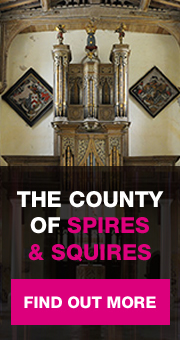Two distinct reasons for coming here: the rare medieval wooden effigies; and the association with the great non-conformist missionary William Carey (1761 – 1834).
A well-positioned medieval church at the far end of this handsome village – the Pury bit of the name reminds us that pears grew here. The medieval church survives thanks to good 19th century restoration. The font is earlier being Norman, although some reconstruction must have occurred here as you will find the lunette decoration is upside down. The stain glass windows are also late 19th century, as are the murals in the chancel by Swinfen Harris.
It is up here that you will find the wooden effigies, thought to be of Sir Lawrence de Paveley and his wife, circa 1340. Adjacent is the early 17th century tomb to the Throckmorton’s who owned the manor here. Unusually and rather touchingly the recumbent couple look into each other’s eyes and their elbows touch.
William Carey was born at Pury End in 1761, his father was a weaver and became both parish clerk and schoolmaster at Paulerspury. The young Carey worshipped in this church before leaving for Piddington when he was 14, it was there he joined the Baptist church and in 1793 left for India as a missionary.
He is known as the ‘father of modern mission’ not just for his work as a Baptist minister, author and translator of the bible into Bengali, but also for founding the missionary college at Serampore in west Bengal. His memorial in the church is adjacent to the south door.
Please refer to the Glossary for any terms in the text that you are unfamiliar with.







